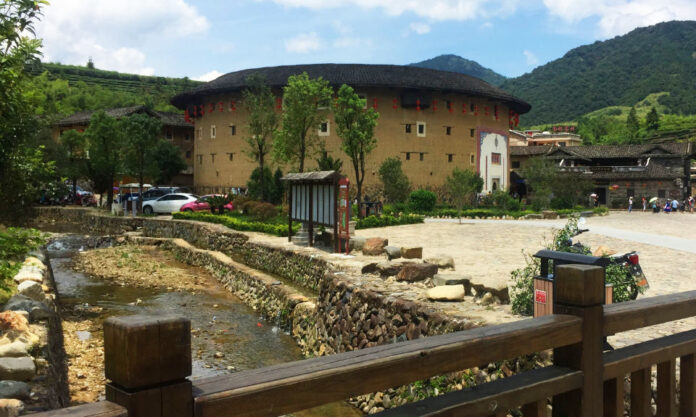Something like a 3-hour trip from tropical Xiamen sit the roundhouses of the Hakka. Declared a UNESCO world cultural heritage site in 2008 due to their unique style and architectural creativity, these houses reached fame due to an amusing misunderstanding, as the locals will tell you.
The story goes that the discovery of the buildings in remote mountain areas was made by the Americans, whose satellites detected the round shapes, leading to the assumption they were missile silos. The American investigator was upon arrival surprised to find nothing more than the traditional round houses (Tulou; 土楼) of the Hakka minority.
When stepping foot into the vast Chengqi Lou (承启楼), nicknamed the “King of Tulous”, you might get lost in the four different rings of which this building is made. In the centre, the ancestral hall becomes the main meeting place for weddings, funerals and the Court. Somewhat shamefully, access to the second floor is forbidden, since the most famous picture of the site is taken from the upper floors of the building. This meant the view for which I had come for was inaccessible!
However, as with most Chinese restrictions, there is a way out! If you look Chinese, the local people will take you up the staircase for ¥30, provided one of the famous Bao’an (security guard) guarding the eight staircases has left his post. My Chinese friend therefore got to sneak upstairs, while I had to wait down below. None of the residents dared take me up with my large nose and round eyes. If caught, they face heavy fines. However, from what I could gather it is possible to stay in Chengqi Lou overnight and therefore go upstairs, after the Bao’an have left. It costs little more than the hotels outside; around ¥80 per night.
The legality of this is better left undiscussed. Since my time was limited, all I could do was let my friend take pictures in my stead.
In the smaller buildings, the Bao’an is usually nowhere to be seen, so at least one can go up for a peek and a photo. In the “King’s” little brother, you might also meet an elder resident who will tell you that he is the owner of the site’s youngest house, which he built with his brothers some 50 years ago. Usually one Tulou houses one family, which seems quite spacious considering Chengqi Lou has 402 rooms. On the other hand, one family is not so little; a former owner had more than 20 sons and daughters.
No one, except inhabitants, dare go up to the second floor. It is a really fascinating sight though; such dark wood that has resisted the weather for so long. However, be sure to heed the locals’ warning, “Only go in there when it’s not raining!”
In Chinese, the roundhouses are called “earthen houses”, due to the material used in erecting the outer walls; a mixture of raw earth, sand, lime, glutinous rice, and brown sugar. The interior of the houses, on the other hand, is constructed entirely of wood. Some of the buildings might be round, certainly Yongding’s largest Chengqi Lou is, but many are also square and very similar to a Beijing Siheyuan. In total there are about 30 different shapes that may constitute the so-called “roundhouses”, making their common English name somewhat of a misinterpretation.
Originally built by the Hakka minority; immigrants from Northern China, the Tulou’s unique architectural style is not only aesthetically pleasing but fulfils a very important practical purpose. Not always welcome due to their status as foreigners, the Hakka faced many attacks and conflicts over resources, in the process developing fortressed homes. Chengqi Lou’s 16-metre-high walls and lack of windows on the lower levels make it impossible to gain entry unless invited in through impenetrable iron gates.
The threat the Hakka must have felt is not only reflected in their architecture but also in their traditions. As one of the local girls tells us, the well on the ground floor used to house a number of fish as a warning system; a Hakka tradition to make sure the water from the well had not been poisoned.
The Hakka presence is no longer very obvious in Yongding, since most residents are from other provinces, as is the case with the young married couple we met from Xinjiang. They, as many other “locals”, earn a living by growing their own tea and selling it to visitors, while the tourist attraction is their home.
“Living here has its good sides and bad sides”, she tells us. “All the neighbours can hear you fight, but this also means they will usually butt in and help you solve your problems.”









